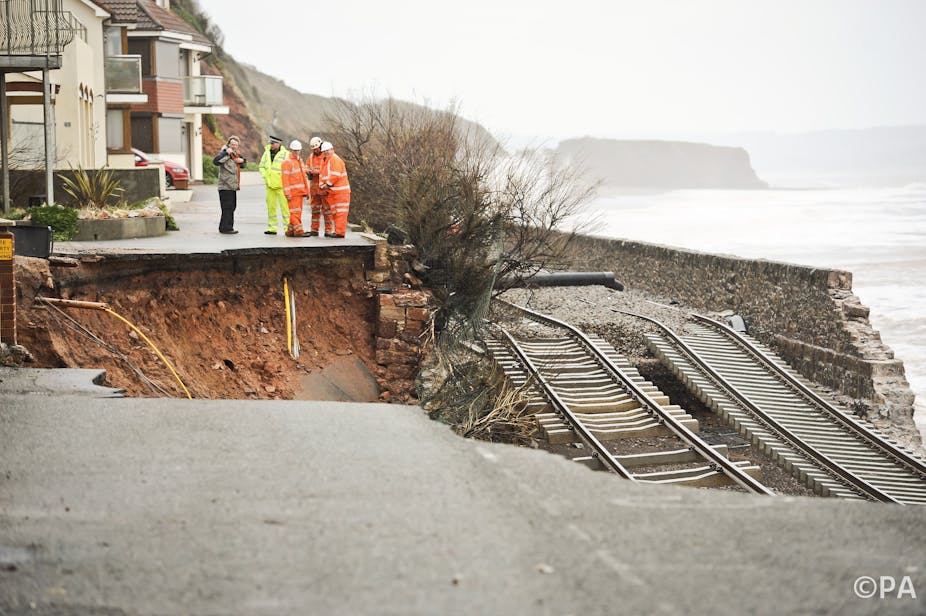The assault on British coastlines by storm, flood and sea this winter is a taste of things to come. Rising sea levels and a greater risk of coastal flooding are a significant future threat. Britain is an island nation, and a great deal of important and expensive infrastructure, from ports and harbours to power stations and industry, lies along the coast. Roads and railway links are also vital – some entire coastal regions’ economies depend on key highways or rail links.
The coastal section of the London-Penzance railway line that runs between Dawlish and Teignmouth in Devon is a perfect example. As the main railway connection for the southwest of England to the rest of Great Britain, it is a vital transport link for the Devon and Cornwall economy. Several sections of the line have just been washed into the English Channel by storms, leaving the tracks hanging suspended in space over the waves. Network Rail’s first repair estimates are 4-6 weeks work, with engineers calling it the “worst damage they’ve seen in their careers”.

Lying so close to sea level, just a few metres above the waves, the line has been susceptible to frequent closure during high seas and storms ever since it opened in 1846. The past 30 years have seen the problem worsen, coinciding with rising sea levels, but the current damage is the most severe in its entire 178 years of service. It is currently estimated that sea-level will by 2020 have risen between 5-7cm from 2010 levels, which by my estimates could double the amount of disruption on the line. By 2050 services could be affected for several months of each year.
It is not a case of if but when the railway will be lost completely to the sea. It is vital that the region prepares for this eventuality, and although Dawlish is arguably the most iconic coastal railway, there are others in North Wales, northwest England and in Scotland that will face similar problems in years to come.
Rising tides
Coastal flooding is most likely when strong storms and low atmospheric pressure combine to drive storm surges towards the coast. Coupled with high tides the effects can be devastating, as shown by the destruction in East Anglia and the Netherlands during the record storm of 1953, when tide levels rose to two metres above the predicted high.
So with sea levels set to rise over the next century, these extreme events could become more frequent. Hard-engineered sea defences such as sea walls, rock armour, and breakwaters have been built to protect coastal communities and the services upon which they depend. Around 1,200km of coastline is protected, around a third of the total coastline of England and Wales. This is particularly evident in southern England.
Defence structures are built to a design standard based on the statistical chance of extreme water levels (such as one in 100 years). But it’s estimated that even small changes in sea level can produce a significant upwards trend to those chances. Other factors such as storminess and frequency of surges, and wave characteristics (known as wave climate) that cause coastal flooding are difficult to predict. Yet even with no changes in these factors the coastal threat, like the sea, is rising.

Living with change
And as tides rise, budgets shrink. Large cuts to national flood defences have been made and are expected to continue, raising serious fears for the funding of planned flood defence improvements along the coast. In the Southwest, plans to re-route the line have been dismissed as too costly. Taken from a purely transport economics or engineering perspective this may well be correct, but this evaluation does not take into account the wider socio-economic benefits of transport connectivity, such as access to employment, productivity gains, increased business opportunities and improved quality of life.
There is an urgent need to improve how the wider socio-economic benefits of transport can be translated into language that beancounters understand. Without investment, the future of Britain’s transport infrastructure services are at risk of failure and collapse, just as surely as the Dawlish-Teignmouth stretch of railway. The cost of clawing back from that eventuality will far outweigh the admittedly high costs of early intervention and adaptation.
While agenda-setting national plans like HS2 and Crossrail steal the limelight, the regional and local lines where infrastructure and services are dense, highly interlinked, and heavily relied upon (especially in rural areas) are slowly abandoned. We must invest in the regional networks to tackle the problems specific to them, such as the Southwest Mainline, as by doing so will improve the resilience of Britain’s transport infrastructure overall.

